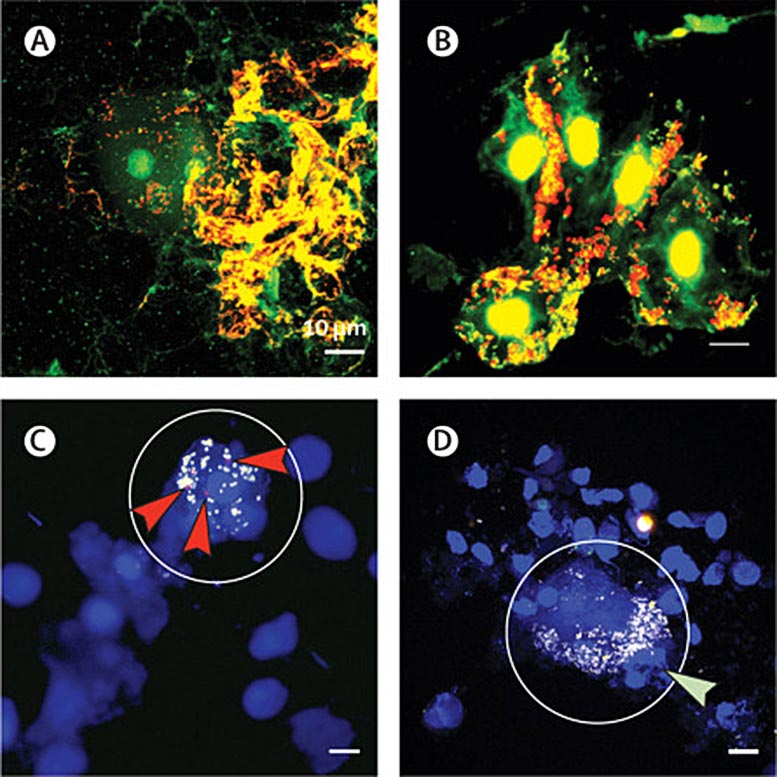
Squamous epithelial cell biofilms observed in bronchoalveolar lavage from children with protracted bacterial bronchitis or bronchiectasis. Representative maximum intensity projections of bronchoalveolar lavage stained with BacLight (A–B), fluorescent in situ hybridization (FISH) probes (C–D), or hematoxylin and eosin (E–F). In BacLight images, DNA within intact (live) bacteria is stained green whereas extracellular DNA and permeable (dead) bacteria are stained red. (A) BacLight-stained bronchoalveolar lavage from a child with protracted bacterial bronchitis (PBB) showing large biofilms containing live and dead bacteria attached to squamous epithelial cells. (B) BacLight-stained bronchoalveolar lavage from a child with bronchiectasis showing live and dead bacteria in biofilms attached to squamous epithelial cells. (C) FISH-stained bronchoalveolar lavage from a child with PBB showing a squamous epithelial cell (SEC) biofilm containing small clusters of Moraxella catarrhalis (red arrows) and other unidentified bacteria (eubacterial probe in yellow) associated with host DNA (blue). The circle indicates the associated squamous epithelial cell. No non-specific hybridization (NONEUB probe in green) was observed. (D) FISH-stained bronchoalveolar lavage from a child with bronchiectasis showing a SEC biofilm that is positive for Streptococcus pneumoniae (green arrow) and other unidentified bacteria (eubacterial probe in yellow) associated with host DNA (blue). The circle indicates the associated squamous epithelial cell. Credit: The Lancet Microbe, DOI: 10.1016/S2666-5247(21)00300-1
New research has led to a breakthrough in understanding an important driver of recurrent chest infections in children.
Many children experience a prolonged wet cough after having an acute cough and can develop a condition called protracted bacterial bronchitis or PBB. In a collaborative study published in the prestigious The Lancet Microbe journal, researchers from Menzies School of Health Research (Menzies), The Telethon Kids Institute and the University of Western Australia (UWA) used a powerful microscope to discover that some of the kids with persistent wet coughs had a bacterial slime – called a biofilm – in their lungs.
Lead author, Menzies Senior Research Fellow, Dr. Robyn Marsh says children with recurrent PBB are at increased risk of progressing to a severe lung disease called bronchiectasis.
“We know that for most kids with PBB, their cough will get better after they have had a two-week course of antibiotics, but we also know that some kids will have repeated episodes of bronchitis that never seem to get better,” Dr. Marsh said.
“This puts them at risk of developing a severe lung disease called bronchiectasis. We know that chest infections can lead to PBB and bronchiectasis, but the reasons why only some kids respond to antibiotics isn’t always clear.”
The research team used a process known as bronchoalveolar lavage (BAL) to collect a sample from the lungs for testing. During the procedure, a sterile solution is used to flush the child’s airways and capture a fluid sample containing the germs that cause the child’s chest infection. This is the first known study to demonstrate a prevalence of biofilm in affected children.
Study co-author Dr. Ruth Thornton a Research Fellow, UWA Centre for Child Health Research (affiliated with the Telethon Kids Institute) says using the powerful microscope with contrasting colors assisted in locating and identifying the bacterial slime which is present in the affected lungs.
“This is an important discovery as we know that when bacteria live in these slimes they can be more than a thousand times more resistant to antibiotics than the bacteria that cause the acute infections that you take your child to the doctor for. This means that when you stop antibiotics your child is likely to get yet another infection,” Dr. Thornton said.
Professor Anne Chang AM, Menzies Head of Child Health described the study results as an exciting way forward to help treat the children who have been suffering.
“This is really exciting. We’ve suspected these children have biofilm-associated infections for a while but until now, no one has proven it. Now that we’ve seen it, we can start investigating new ways to treat these children so that fewer of them will progress to having severe lung disease,” Prof Chang said.
Reference: “Prevalence and subtyping of biofilms present in bronchoalveolar lavage from children with protracted bacterial bronchitis or non-cystic fibrosis bronchiectasis: a cross-sectional study” by Robyn L Marsh, PhD; Michael J Binks, PhD; Heidi C Smith-Vaughan, PhD; Maxine Janka, BSc; Sharon Clark, BBioMedSc; Prof Peter Richmond, MD; Prof Anne B Chang, PhD and Ruth B Thornton, PhD, 1 February 2022, The Lancet Microbe.
DOI: 10.1016/S2666-5247(21)00300-1
Menzies School of Health Research
Menzies is one of Australia’s leading medical research institutes dedicated to improving the health and wellbeing of Aboriginal and Torres Strait Islanders, and a leader in global and tropical research into life-threatening illnesses, Menzies continues to translate research into effective partnerships and programs in communities across Australia and the Asia-Pacific region.

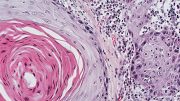
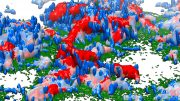
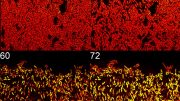
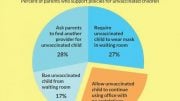
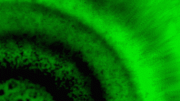

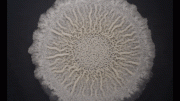

Be the first to comment on "Bacterial Slime in Lungs Causing Persistent Wet Coughs for Children"